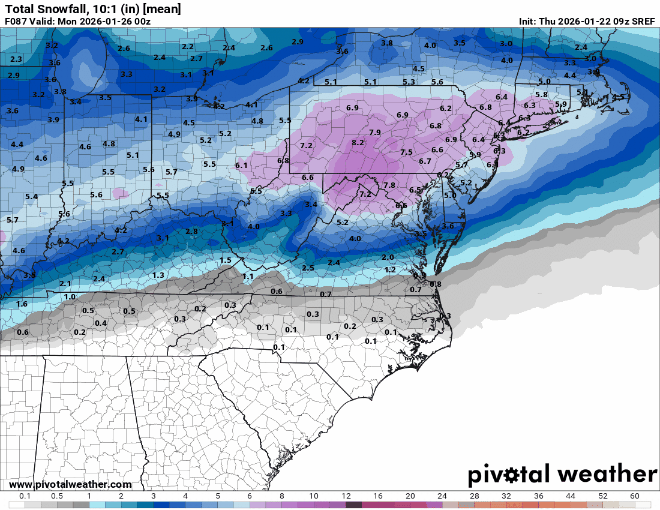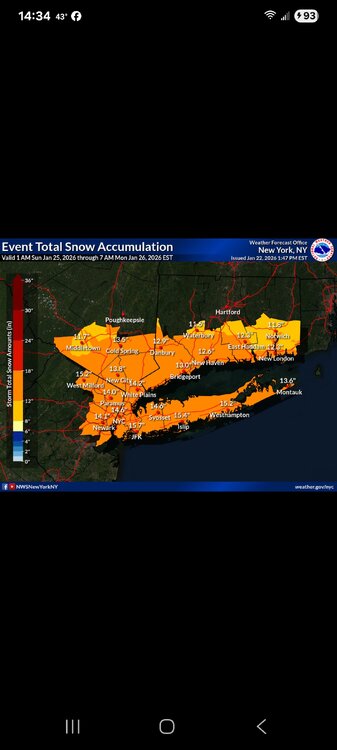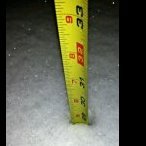All Activity
- Past hour
-
I guess its as good as anything we can guess on. conservative in some cases and kinda broad brushed from WSW to ENE. you think Roanoke and Salisbury will have similar outcomes? I mean maybe taking into account the orographic lift vs. the coast taking over. we shall see.
-
Possible Record Breaking Cold + Snow Sunday 1/25 - Tuesday 1/27
eduggs replied to TriPol's topic in New York City Metro
They generally don't like to make big changes shift to shift to avoid a windshield wiper effect. Heavier snow to the south reflects the model consensus from a day or two ago. If the further north solutions persist, future maps will gradually reflect that. -
Possible Record Breaking Cold + Snow Sunday 1/25 - Tuesday 1/27
BoulderWX replied to TriPol's topic in New York City Metro
Yeah I’m confused. They have 12-16 for me. -

Possible Record Breaking Cold + Snow Sunday 1/25 - Tuesday 1/27
OrangeCTWX replied to TriPol's topic in New York City Metro
From their winter weather page. Just select it, click copy, and paste it in lol -
That High supports snow for linger than us bring recognized I believe. My idea has been and hasn’t changed that DC to Balt area is in for a 10-15” event
-
Southern MD / Lower Eastern Shore weather discussion
AlexD1990 replied to PrinceFrederickWx's topic in Mid Atlantic
havent seen that since 2015 i think? fun times... -
First call map isn’t bad my friend!! I do think mixing will end up further north than what you have, but you have the right idea. Let me tell you, I am impressed at your acumen and intelligence to grasp some of this complex meteorology at your age. I was following along at your age once upon a time, learning and taking in things like a sponge. You are doing great and ahead of the game. You and @SnowenOutThere keep up the great work. It’s been a cool sight watching you two both grow up and learn on here. Now go eat some crayons!!! You’re making us all look bad
-
Damage in the drizzle. That’ll be my thing to watch during this storm. We don’t want slack rates.
-
This storm gave us the finger a couple of days ago.
-

Possible Record Breaking Cold + Snow Sunday 1/25 - Tuesday 1/27
wthrmn654 replied to TriPol's topic in New York City Metro
How did you get that lol -

January 25/26 Jimbo Back Surgery Storm
Brick Tamland replied to Jimbo!'s topic in Southeastern States
I am just hoping area B is farther south now. -
January 25/26 Jimbo Back Surgery Storm
stormwatcherJ replied to Jimbo!'s topic in Southeastern States
I need B to slide a little south into D, lol -
-

Possible Record Breaking Cold + Snow Sunday 1/25 - Tuesday 1/27
Nibor replied to TriPol's topic in New York City Metro
Agreed -
If I get 18” of snow and sleet I’ll go nuts. I’m expecting more like 10” and 1-2” sleet.
-

2025-2026 Fall/Winter Mountain Thread
Tyler Penland replied to Buckethead's topic in Southeastern States
If you check the hourly it is probably rain through midnight, then a temperature freefall to 15 at sunrise behind the front. -

Possible Record Breaking Cold + Snow Sunday 1/25 - Tuesday 1/27
wthrmn654 replied to TriPol's topic in New York City Metro
-
BigCountry started following Mid Atlantic
-

Possible Record Breaking Cold + Snow Sunday 1/25 - Tuesday 1/27
OrangeCTWX replied to TriPol's topic in New York City Metro
This should appease the masses. -
BigCountry started following January 24-26: Miracle or Mirage Thread 2
-

Pittsburgh/Western PA WINTER ‘25/‘26
colonel717 replied to Burghblizz's topic in Upstate New York/Pennsylvania
-
Why is that map 2024? Sent from my SM-S916U using Tapatalk
-
Thats exactly where we need it to be!
-

January 24-26: Miracle or Mirage JV/Banter Thread!
WxUSAF replied to SnowenOutThere's topic in Mid Atlantic
I’m done with model plots lol. Ready to watch snow fall. -

Possible Record Breaking Cold + Snow Sunday 1/25 - Tuesday 1/27
MANDA replied to TriPol's topic in New York City Metro
Wouldn't you think they would want it the other way? I don't know, I would think they would will the public's confidence by going down more so than going up. I won't beat it to death. -
Thanks!
-
Bitchin Nachos!! Nice write up and map. I toast you a cold frosty Capri Sun!











.thumb.jpg.9707d4addca3d84715ae3d888c5c10d6.jpg)
